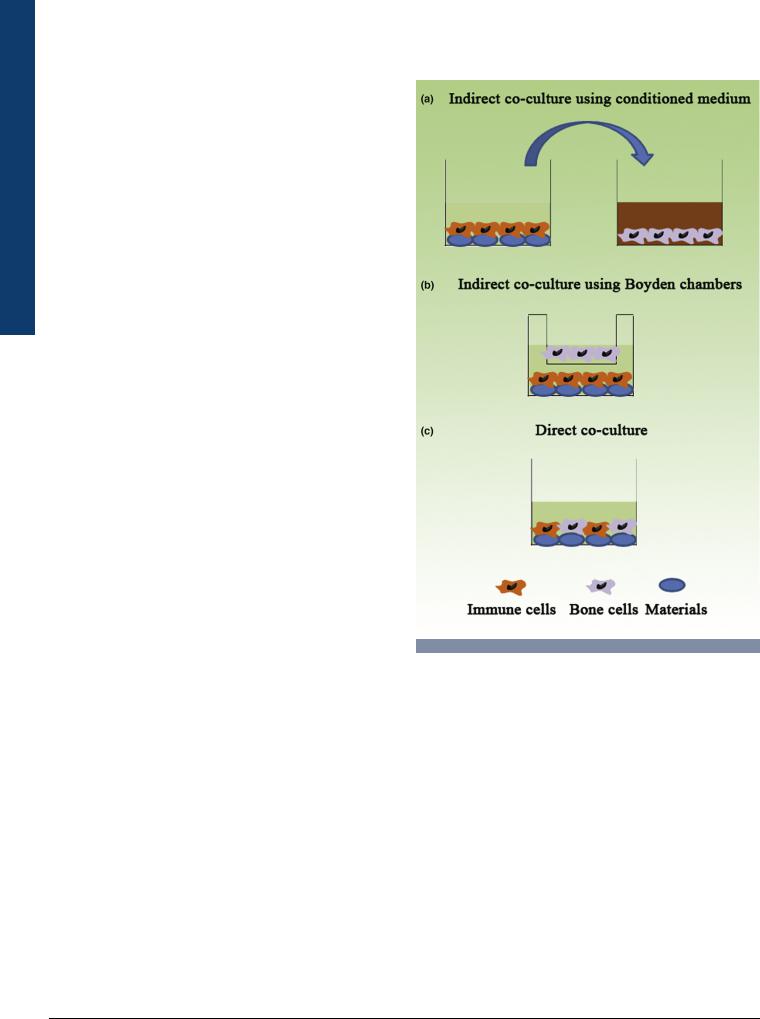
- •Introduction
- •Overview of the integration between bone tissue and implants
- •Immune cells and osteoclastogenesis
- •Immune cells and osteogenesis
- •Multiple roles of macrophages in the bone healing process
- •Bone biomaterials modulating the immune response
- •Surface properties of bone biomaterials
- •Biomaterials particle size
- •Porosity and pore size of biomaterials
- •Released ions from bone biomaterials
- •Indirect co-culture using conditioned medium
- •Indirect co-culture using Boyden chambers
- •Direct co-culture
- •Possible evaluation process of osteoimmunomodulation
- •Possible strategies to endow advanced bone biomaterials with favorable osteoimmunomodulation
- •Conclusions
- •Acknowledgements
- •References

Review RESEARCH:
RESEARCH |
Materials Today Volume 19, Number 6 July/August 2016 |
avoiding excessive bone resorption. Materials with poor OIM properties will cause excessive inflammation, an imbalance of osteoclastogenesis over osteogenesis and lead to the destruction of normal bone tissue and the formation of a fibrous capsule. Such materials would, therefore, be excluded from further preclinical or clinical testing.
Evaluation of OIM will be challenging, because it involves the interaction between biomaterials, bone cells, and immune cells but can be achieved by applying a co-culture system that includes all three factors. The co-culture systems are outlined below and would include indirect co-culture using conditioned medium, indirect co-culture using Boyden chambers, and direct co-culture (Fig. 7).
Indirect co-culture using conditioned medium
Immune cells are first cultured on bone biomaterials to stimulate an immune response. The conditioned medium will subsequently be applied to osteoblastic and osteoclastic cells, to determine its effects on osteogenesis and osteoclastogenesis, respectively. This model has the advantage of being a short and simple procedure [183]. Conditioned media can be frozen down so that the same batch of medium can be used for several replicates. Not only that, it can also be applied when immune cells and bone cells are from different species, thereby extending the range of applications (direct co-culture system requires the use of cells from the same species, since immune cells will react to xenogeneous cells and trigger an unwanted immune reaction). It should be noted that one potential complication, when comparing to a non-condi- tioned medium, is the variation in levels of other aspects of the medium (such as glucose and serum components).
Instead of playing a passive role during the interaction with immune cells, bone cells actively regulate the immune response. For example, parathyroid hormone stimulated osteoblasts can express CXCL12 and IL-7, which are known to regulate B cell development [184]. Osteoclasts have recently been found to have innate immune cell properties and participate in the systemic immune responses [185] by secreting TNF and other cytokines, such as IL-1, IL-6 and VEGF-C [186,187], thereby auto-amplifying osteoclastogenesis and enhancing inflammation. MSCs are also recognized as having immunomodulatory properties that protects against excessive inflammation [188]. Activated MSCs can induce the alternative macrophage phenotype M2 [189], which reduces inflammation and speeds up the healing process. This mechanism involves the expression of prostaglandin E2 (PGE2) that acts on macrophages via the prostaglandin EP2 and EP4 receptors [190,191]. They can also express TNF-a stimulated gene/protein 6 (TSG-6) and IL-1ra to decrease the amplifying effects of proinflammatory cytokines (IL-1, IL-6, and TNF-a) [192,193]. Therefore, indirect co-culture using Boyden chambers or direct coculture can better mimic the in vivo environment, in relation to the interaction between bone cells and immune cells.
Indirect co-culture using Boyden chambers
The initial phase of the biomaterials/host body reaction is typically an acute inflammation that results in immune cells attaching to the surface of the materials before bone cells, which therefore elicit a greater effect during the early stages of biomaterials mediated osteogenesis. For this reason, in an indirect co-culture system, the
 FIGURE 7
FIGURE 7
Suggested evaluation methods for the osteoimmunomodulation. All three factors (bone biomaterials, immune cells, and bone cells) should be involved in the system of evaluation. (a) Immune cells first interact with biomaterial, and then the effects of the created immune environment (conditioned medium) on osteogenesis/osteoclastogenesis are tested in bone cells. (b) Bone cells are indirectly contact with immune cells/ biomaterials; the Boyden chambers allows cell migration or molecular penetration depends on the Boyden chambers pore size. (c) Bone cells and immune cells are co-cultured on the biomaterials directly.
immune cells can be cultured in indirect contact with the materials and the bone cells in a Boyden chamber insert. The small pore size (such as 0.4 mm) of the insert keeps the bone cells within the insert but allows secreted molecules to flow freely. Such an approach allows for the study of the molecular communications that results from the interaction between bone cells and immune cells in relation to the bone biomaterials. Changes to bone cells and immune cells, including gene and protein expression, can be investigated separately, which allows for greater resolution in unraveling the underlying mechanisms. By using larger pore sizes (3.0 mm or larger depending on the cell size), the migration of bone cells can also be investigated, to study the effect of chemoattractant that results from stimulated immune cells.
316
